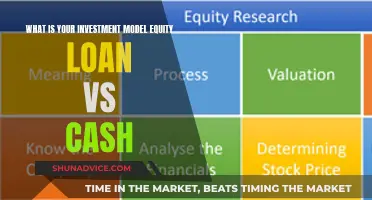
Margin trading involves borrowing money from a broker to buy stocks, increasing potential gains and losses. Margin trading is not without its risks, and it is not suitable for all investors. While it can magnify your gains, it can also magnify your losses.
Margin trading is best left to professionals as it requires a good understanding of the mechanics involved. Before deciding to invest using margin, it is important to carefully consider the benefits and risks and assess your financial circumstances and risk tolerance.
| Characteristics | Values |
|---|---|
| Definition | Investing with money borrowed from a broker |
| Types of accounts | Cash account, Margin account |
| Interest on margin loans | High |
| Margin call | Requires additional funds during market dips, potentially forcing sales of stocks at losses |
| Primary types of brokerage accounts | Cash account, Margin account |
| Buying stocks on margin | Borrowing money from a broker to buy securities |
| Leverage | Increase in gains and losses |
| Net profit | Reduced |
| Investment risk | Increased |
| Brokerage firms' requirements | Minimum amount in the account before borrowing from the broker |
| Tax-deductible interest | Yes |
| Risk | High |
| Repayment flexibility | Yes |
What You'll Learn

Margin trading can magnify gains and losses
Margin trading can be a double-edged sword, offering the potential for magnified gains but also increasing the risk of substantial losses.
When an investor trades on margin, they borrow money from a broker to purchase stocks or other financial assets. This allows them to buy more stocks than they could otherwise afford, increasing their potential gains if the stock price rises. For example, if an investor owns Rs 20,000 but wants to purchase shares worth Rs 50,000, they can utilise margin trading by paying a percentage of the total amount. If the broker sets a 20% margin requirement, the investor pays Rs 10,000, and the broker lends the remaining Rs 40,000. Should the stock price increase, the investor's gains will be amplified as the percentage return on their invested amount will be higher.
However, the same mechanism that amplifies gains also magnifies losses. If the stock price declines, the investor's losses will be greater than if they had only purchased stocks with their own funds. For instance, in the previous example, if the Rs 50,000 worth of shares decrease in value to Rs 40,000, the investor will have lost their entire initial investment of Rs 10,000, plus an additional Rs 10,000. Furthermore, if the investor does not sell their shares before the specified time, the broker can sell the shares and liquidate the assets to minimise potential losses.
Additionally, margin loans typically carry high-interest rates, which can reduce net profits and increase investment risk. Investors should also be mindful of margin calls, which occur when the broker demands the investor deposit more funds during market dips to maintain the margin. Failure to meet a margin call can result in the broker forcibly selling the investor's positions to satisfy the call, which may occur at unfavourable prices.
In summary, while margin trading can magnify gains, it also significantly increases the risk of substantial losses. Investors considering margin trading should carefully assess their risk tolerance, conduct thorough research, and be prepared to meet margin calls and manage the associated costs.
Probability Strategies for Smart Investing
You may want to see also

Margin loans are not risk-free
The primary dangers of trading on margin are leverage risk and margin call risk. Leverage risk means that margin can magnify your losses just as dramatically as it can boost returns. Margin call risk refers to the possibility of being unable to meet a margin call. If the value of the securities you are using as collateral for your margin loan falls below the minimum equity maintenance requirement, your account may incur a margin call. This means you will need to add cash or securities to your account to increase your equity. If you do not act promptly, your brokerage firm may sell securities you own—without notifying you—in order to increase the equity in your account.
If your positions lose value too quickly and your margin loan balance exceeds the proceeds from the securities your broker closed out, you could end up with no securities at all, but still owing money.
In a margin account, your positions will usually be more sensitive to day-to-day market fluctuations, and if there is a really sharp decline, you could end up losing more than the total value of your account.
Interest on margin loans can be high, reducing net profit and increasing investment risk compared to traditional investing.
Retirement Investing: Strategies for Your Cash Reserves
You may want to see also

Margin calls can be issued if the account market value declines
The maintenance margin is the minimum value that an investor's equity in a margin account must be to meet minimum capital requirements. This is usually set at 25% of the total market value of securities but can be higher, depending on the broker.
If an investor's equity falls below this level, they will be issued a margin call. They will then have to either deposit more funds or securities into their account to meet the minimum value or sell some of the assets in their account. If they are unable to do this, the broker may sell securities in the investor's account without their permission to meet the minimum value.
To avoid a margin call, investors can keep extra cash on hand to deposit into their account if necessary, diversify their portfolio to limit volatility, and track their account closely to stay aware of its value.
Understanding Dividend Investing: Yield on Cash
You may want to see also

Margin accounts offer faster and easier liquidity
For example, investors usually have to wait three days after selling securities to withdraw cash. However, a margin account lets investors borrow funds during this three-day waiting period. Although investors will have to pay interest on the loan, the cost is minimal. For instance, a margin loan of $10,000 at 5% interest would cost less than $2 per day.
Margin accounts also enable investors to borrow money to invest with. This can amplify profits, especially in bull markets. However, this strategy is best left to full-time traders or professionals as it is extremely risky.
The primary danger of margin trading is that it can magnify losses just as dramatically as it boosts returns. If an investment purchased on margin declines in value, an investor may lose not only their initial equity investment but also additional capital to lenders.
Another risk is the possibility of a margin call. If the value of the securities used as collateral for a margin loan falls below the minimum equity maintenance requirement, a margin call will be triggered. This means the investor will need to add cash or securities to their account to increase their equity. If they do not act promptly, their brokerage firm may sell securities to increase the equity in their account without their approval.
Overall, while margin accounts offer faster and easier liquidity, they also come with significant risks that investors should be aware of.
Unlocking Investment Strategies with Equity
You may want to see also

Margin trading is not suitable for beginners
Margin trading involves borrowing money from a broker to buy more securities than an investor could otherwise afford. This can amplify returns, but it also amplifies losses.
Margin trading is a risky strategy that requires a high level of discipline and risk management. It is easy to get carried away with leverage and take on more risk than is prudent. The interest rates on margin loans can be high, and there is also the risk of a margin call, where the broker demands more funds or sells securities at a loss.
Because of the risks involved, margin trading is usually best left to professionals. Beginners should avoid trading on margin as it is not always clear how much has been borrowed and how much equity is held.
The primary dangers of trading on margin are leverage risk and margin call risk. Leverage can magnify losses just as dramatically as it can boost returns. If the market moves against the investor's position, they may be forced to sell securities at a loss or deposit additional funds to meet the margin call.
Margin trading also requires managing the collateral, which can be challenging for beginners.
Maximizing Investment Returns with Relative Strength Strategies
You may want to see also
Frequently asked questions
A margin account is a type of brokerage account that allows you to borrow money from your broker to buy stocks or other securities. It gives you more options but also comes with more risk.
Investing using margin allows you to leverage your account and buy more stocks than you would normally. It can magnify your portfolio gains and help you profit from share price declines. It can also act as a convenient line of credit and provide flexibility in terms of short-term cash flow.
The main risk of investing using margin is that it can magnify your losses just as much as it can boost your returns. If the value of your stocks or securities declines, you may receive a margin call, requiring you to deposit additional funds or sell your stocks at a loss. Additionally, margin loans typically come with high-interest rates, which can reduce your net profit.
To trade on margin, you need to open a margin account and obtain approval for the loan. The amount you can borrow depends on the value of the assets in your account and the requirements set by your broker and regulatory bodies. You are charged interest on the loan, which must be repaid regardless of whether your investments gain or lose value.
Margin trading is generally not recommended for beginner investors due to its inherent risks. It is considered a sophisticated strategy that requires a good understanding of the mechanics and potential consequences.







